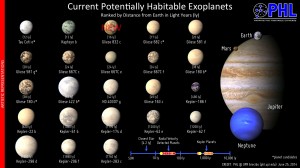
The Habitable Exoplanets Catalog now has 23 objects of interest including Gliese 832 c, the closest to Earth of the top three most Earth-like worlds in the catalog.Credit: PHL @ UPR Arecibo
So close, yet so far…Gliese 832 c is the nearest best habitable world candidate to date.
An international team of astronomers, led by Robert Wittenmyer from the University of New South Wales, Australia, have reported the discovery of a new potentially habitable Super-Earth around the nearby red-dwarf star Gliese 832 – a mere hop, skip and a jump away at sixteen light years!
Earth Similarity Index
According to the Planetary Habitability Laboratory (PHL) at the University of Puerto Rico at Arecibo, Gliese 832 c has an “Earth Similarity Index (ESI)” making it one of the top three most Earth-like planets with respect to our planet’s stellar flux and mass.
However, other unknowns such as the bulk composition and atmosphere of the planet could make this world quite different to Earth and non-habitable.
Gliese 832 c is a prime object for follow-up observations.
Dynamical role
The star, Gliese 832, is already known to harbor a cold Jupiter-like planet, Gliese 832 b, discovered in 2009.
So far, the two planets of Gliese 832 are a scaled-down version of our own Solar System, with an inner potentially Earth-like planet and an outer Jupiter-like giant planet.
The giant planet may well have played a similar dynamical role in the Gliese 832 system to that played by Jupiter in our Solar System.
Rare architecture
As noted by the PHL, “it will be interesting to know if any additional objects in the Gliese 832 system (e.g. planets and dust) follow this familiar Solar System configuration, but this architecture remains rare among the known exoplanet systems.”
The new planet, Gliese 832 c, was added to the PHL Habitable Exoplanets Catalog along with a total of 23 objects of interest. The number of planets in the catalog has almost doubled this year alone, according to a PHL press statement.
The original research by Wittenmyer, Mikko Tuomi and colleagues, can be found here:
http://arxiv.org/abs/1406.5587
By Leonard David
